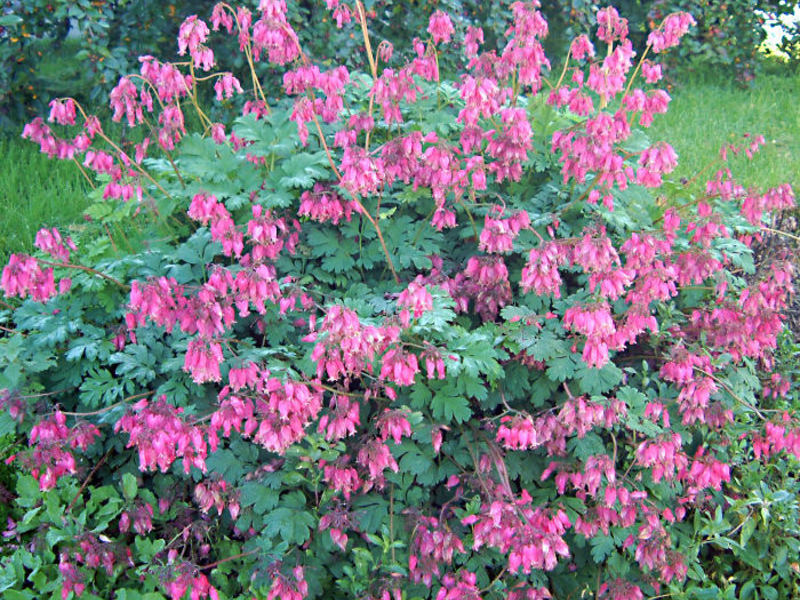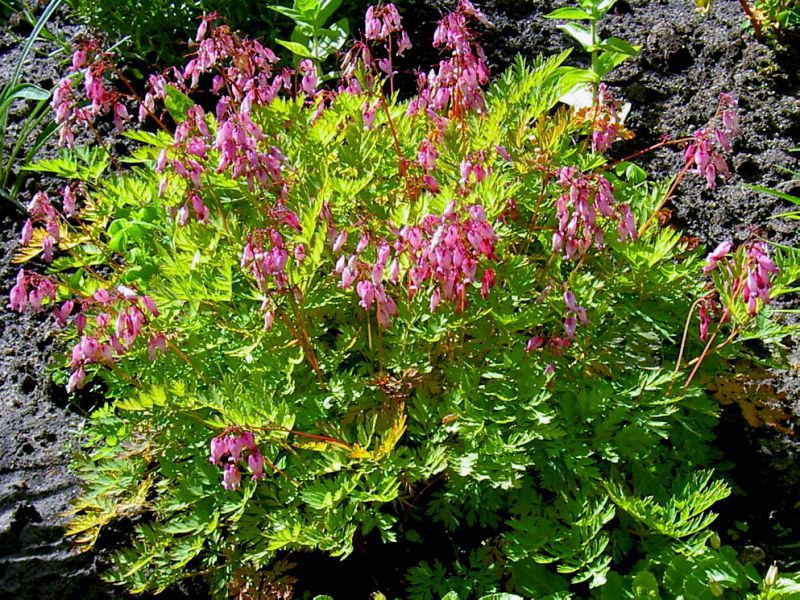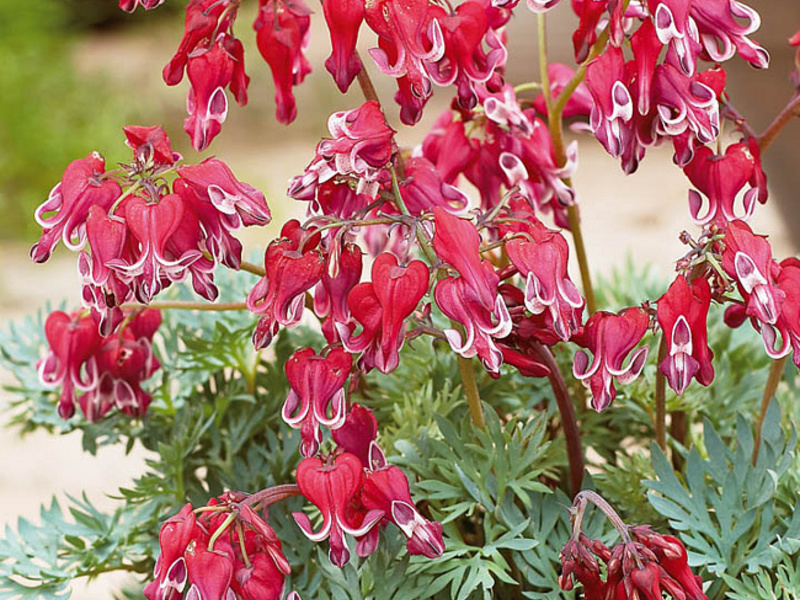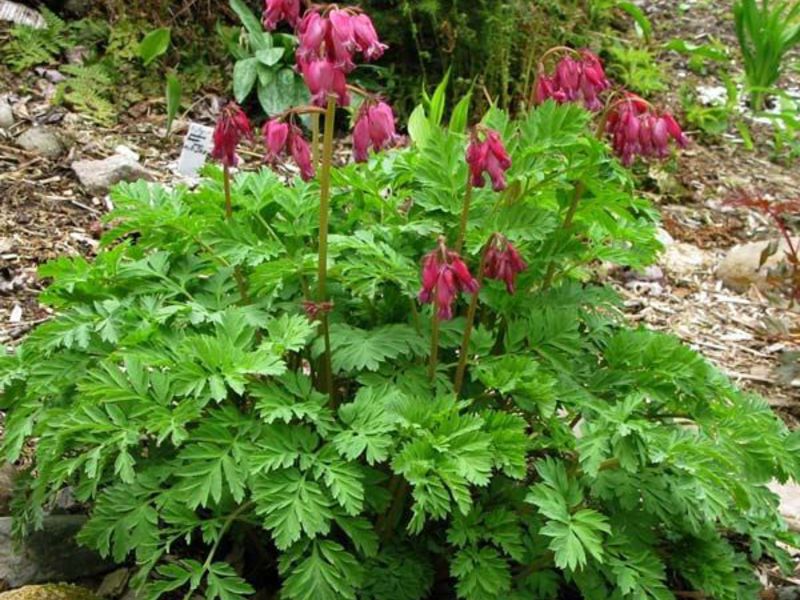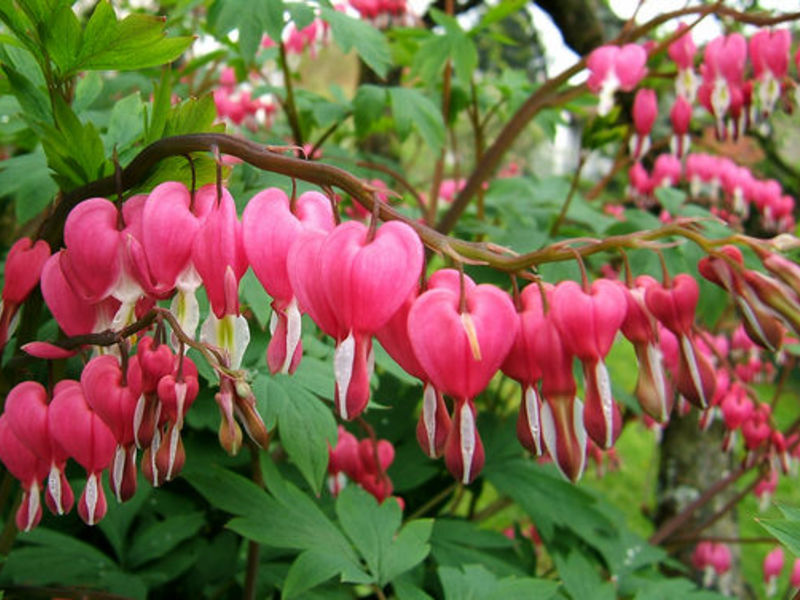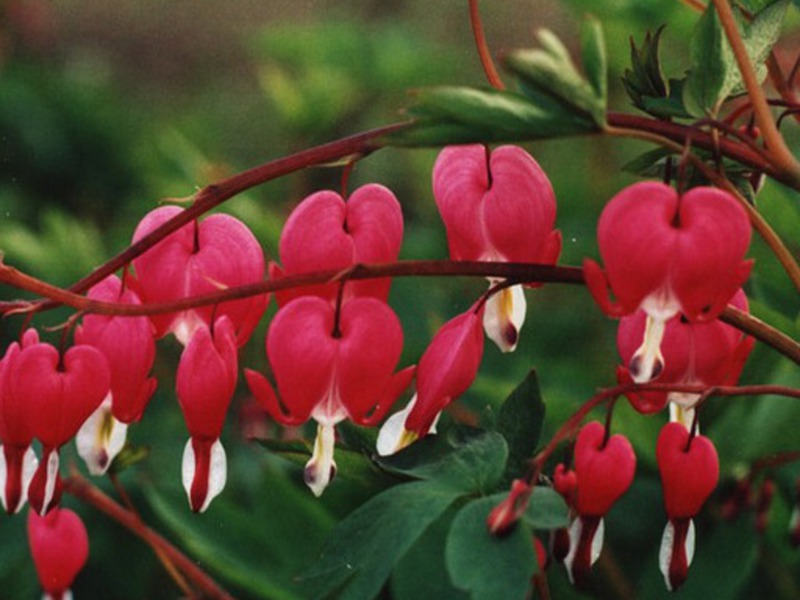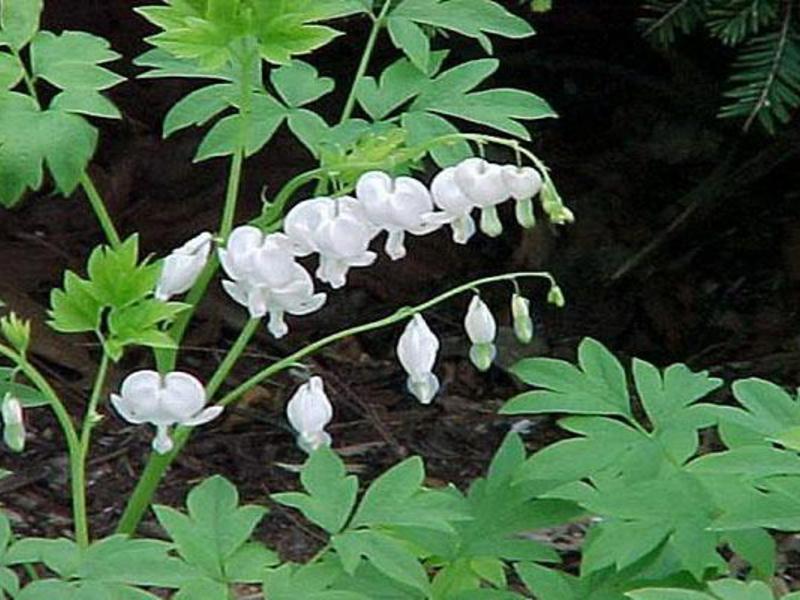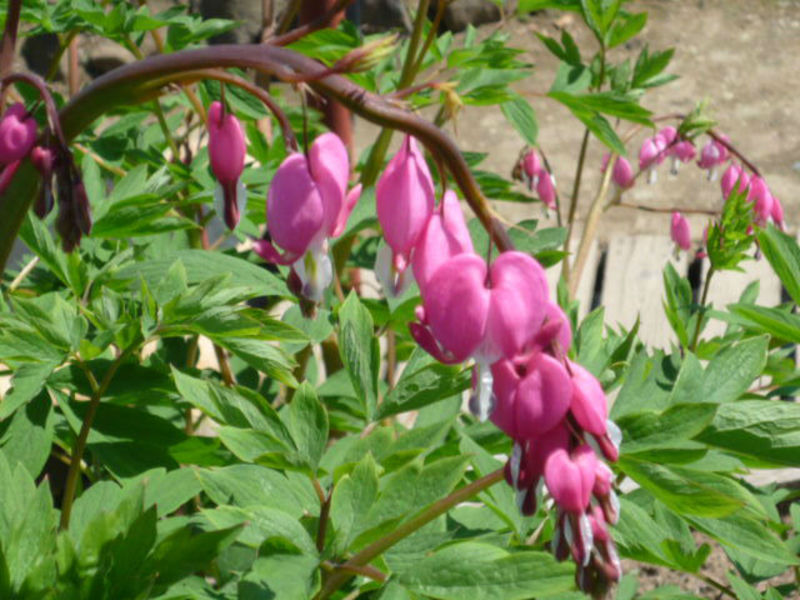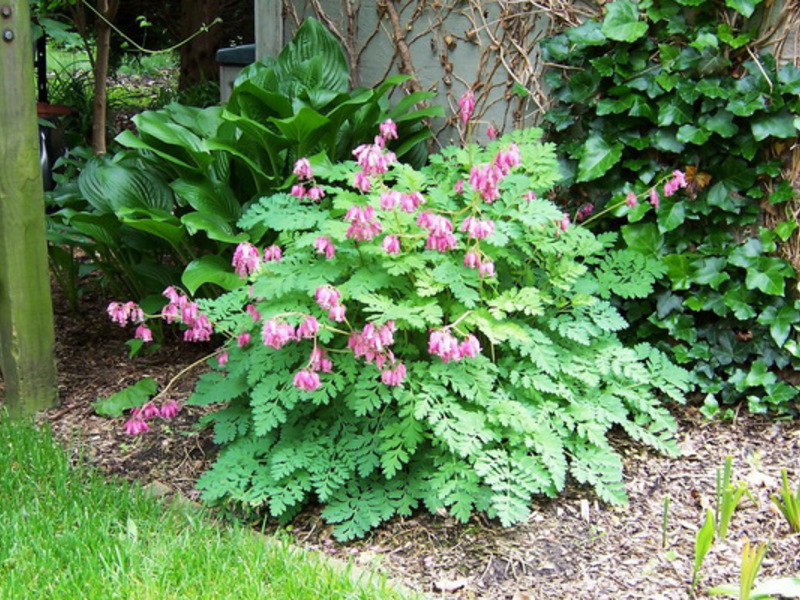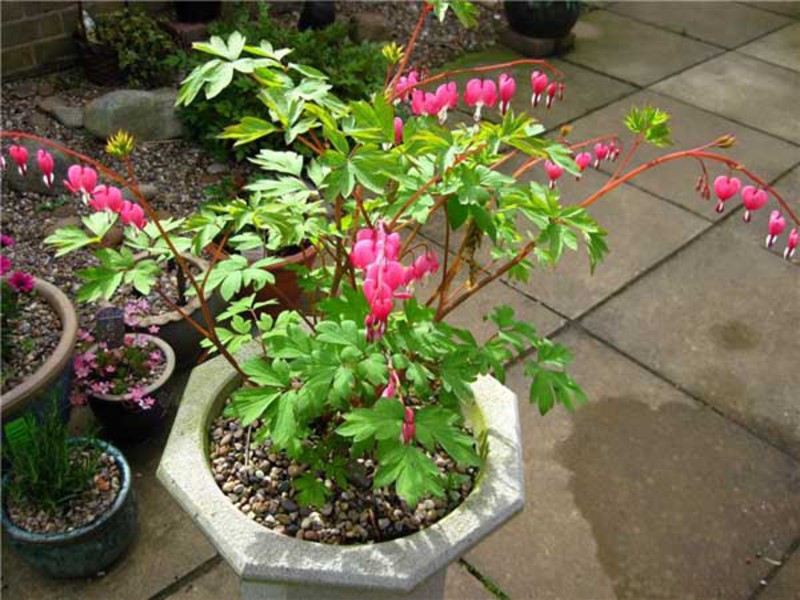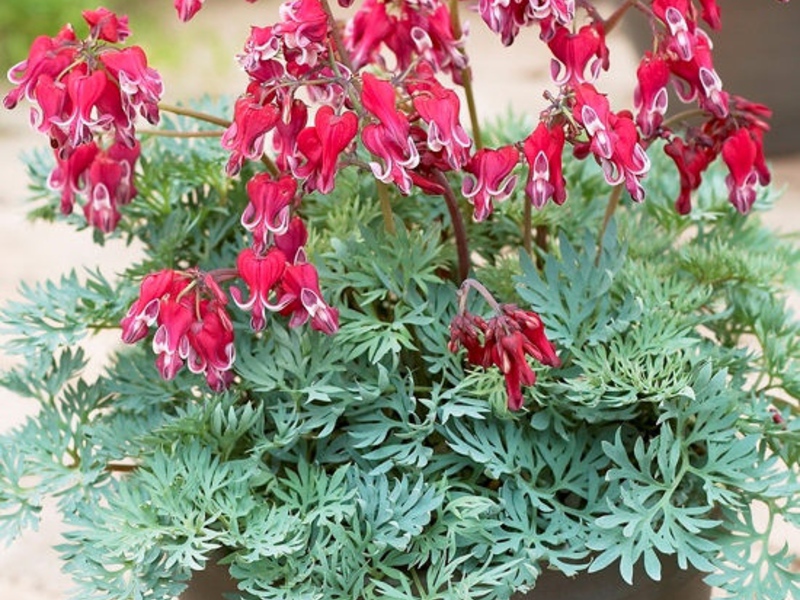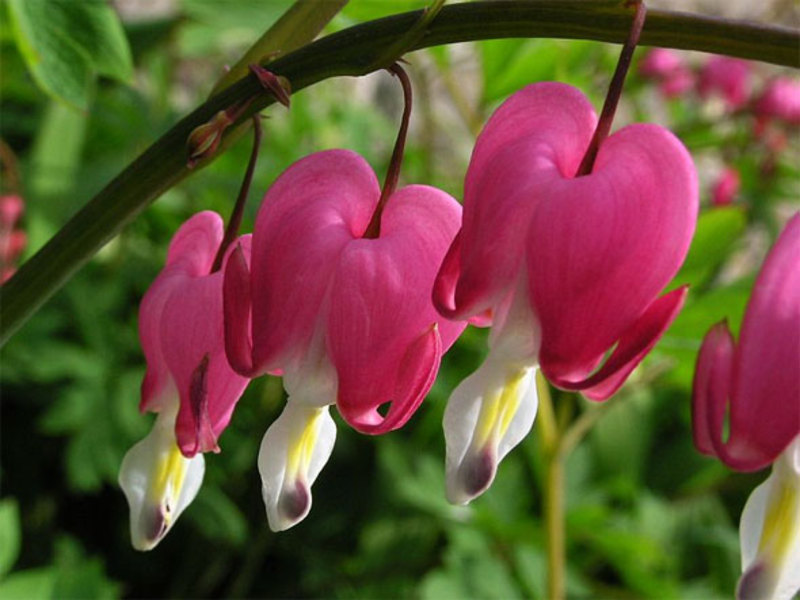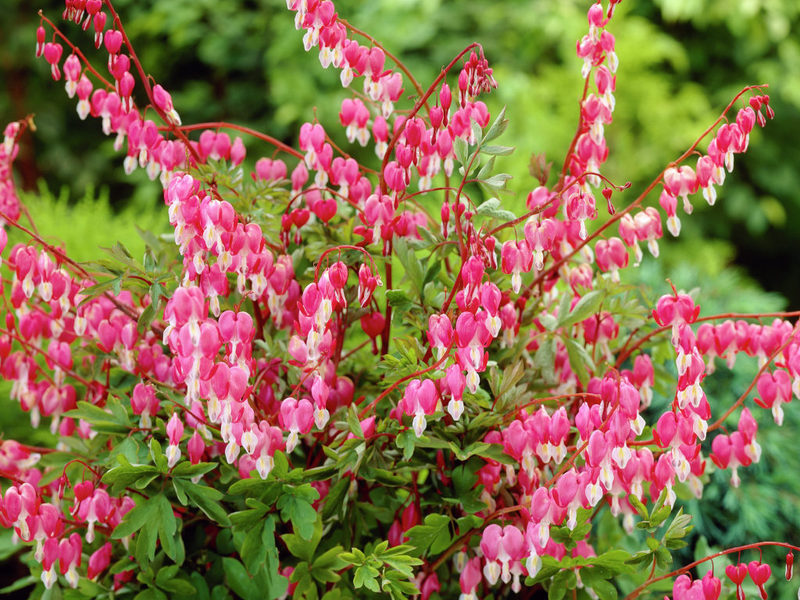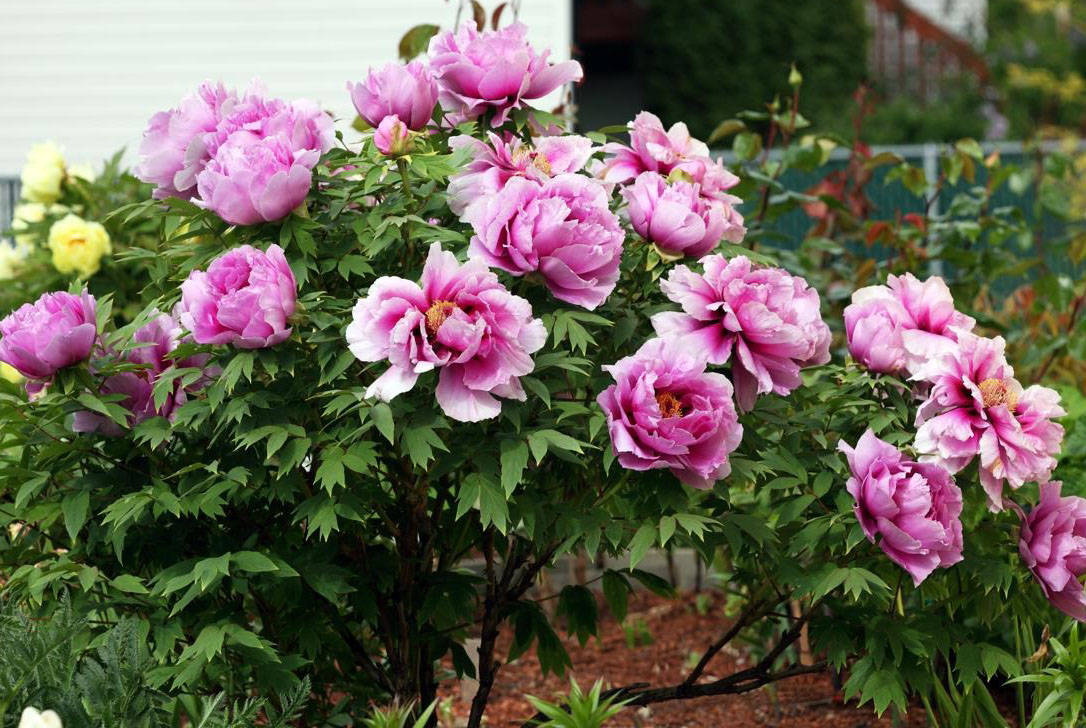Many gardeners do not think too much about how best to decorate the area next to the country house. Therefore, most often they prefer rose bushes, thickets of gladioli or delicate marigolds and calendula. However, they all look quite traditional, so if you want to achieve the original design of your backyard territory, then you will certainly be interested in such an unusual plant as the dicentra.
Already in the first weeks of spring, this flower will begin to give you joy. thanks to the opened buds-hearts... And you can observe this beauty until the middle of summer. However, such an opportunity will be presented to you provided that you grow the dicenter in accordance with certain rules.
The name of the plant bleeding center is most often used in their circles by specialists. In the common people, this flower is known as "broken heart". And I must say that he justifies him, because his buds are very similar to small hearts. Also, this plant is known as a two-spur. This name is formed from two words: dis and kentron, which in a literal translation will sound like "Twice" and "spur"... The French, accustomed to ascribing beautiful legends to different plants, awarded the dicenter the name "Jeanette's heart", practical Germans called it "the flower of the heart", the cunning Englishmen use the name "lady in the bath". In our country, the name “broken heart” was stuck behind the dicenter.
It is erroneous to believe that this the plant was bred in Europe... In fact, his homeland is Japan, and from there he was brought to Europe in 1816. This plant, which stands out for its beauty, did not go unnoticed by local florists. Therefore, many aristocrats and nobles very soon wanted to see the dicenter in their gardens, which stands out for its bright color palette and the original shape of the buds. Because of the love for this exquisite flower, some varieties have even received self-explanatory names. Therefore, many species of dicentra have prefixes like - beautiful, excellent, graceful.
Content
Preparing the soil for planting a flower
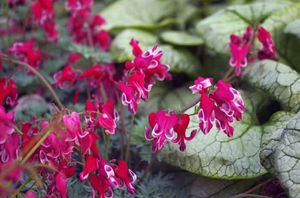 The dicentra is an unpretentious plant, but it is still advisable to prepare a place for planting in the fall. Then, with a greater degree of probability, you can count on the fact that in the spring it will bloom profusely. Dicenter undemanding to growing placestherefore it can be planted in sunny areas and in the shade of trees. However, you immediately need to be prepared for the fact that when planted in partial shade, it will begin to bloom later than usual.
The dicentra is an unpretentious plant, but it is still advisable to prepare a place for planting in the fall. Then, with a greater degree of probability, you can count on the fact that in the spring it will bloom profusely. Dicenter undemanding to growing placestherefore it can be planted in sunny areas and in the shade of trees. However, you immediately need to be prepared for the fact that when planted in partial shade, it will begin to bloom later than usual.
When preparing a site for planting a dicenter, the first step is to dig up the ground, making a flower bed 40 cm deep.You also need to take care of its fertility, therefore, in some cases, it may be necessary to add humus in accordance with the scheme - 3 kg per 1 sq. m. To provide plants with mineral elements, you can use universal fertilizers for garden flowers: they are applied in an amount of 15-20 grams.for 10 liters of water.
After waiting for flowering, it is necessary again carry out top dressing - at least 3-4 times... So you will be sure that during the growing season the bicentre will grow well and will give you beautiful bright flowers. After another rain or watering, it is necessary to loosen the soil in the root zone. However, this must be done with great care, since the roots of the dicentra are located in the surface layer.
The dicentra feels best on light-textured soils with good moisture and air permeability. When growing dicenters on heavy, clayey soils, river sand or peat will have to be added in the fall. These components will help avoid root rot. Often, gardeners practice a method in which a cake is created from dry straw or reeds in the fall. It is placed in the form of layers that mix with the ground, and for it you will first have to dig a special hole.
Best ways to reproduce and transplant
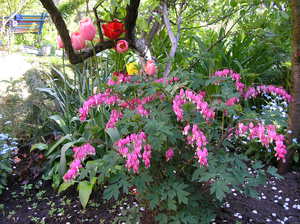 Usually, dicenter is used for breeding rhizome division method, reproduction by aerial shoots and sowing of seeds. The latter option is the least preferred due to the fact that very few seeds are formed in plants. Moreover, there are varieties that, when grown in temperate latitudes, do not form seeds at all. In addition, it is not so easy to grow seedlings from seeds. For this reason, it is best to propagate the dicenter by depositing parts of the rhizome or shoots.
Usually, dicenter is used for breeding rhizome division method, reproduction by aerial shoots and sowing of seeds. The latter option is the least preferred due to the fact that very few seeds are formed in plants. Moreover, there are varieties that, when grown in temperate latitudes, do not form seeds at all. In addition, it is not so easy to grow seedlings from seeds. For this reason, it is best to propagate the dicenter by depositing parts of the rhizome or shoots.
Reproduction by dividing the rhizome
It is recommended to propagate the dicenter by the excellent method of division at the end of summer, since it is at this time of the year that the ground shoots begin to die off. To do this, you need to carefully dig roots from the ground and let them dry... As a result, they will become more elastic, which will reduce the risk of damage. After that, they are engaged in the division of the rhizome, as a result of which segments with 3-4 buds should be obtained, from which shoots will grow in the future.
For planting pieces of roots, you must select an area that is least illuminated by the sun. After digging into the ground, it is necessary to thoroughly water it with warm water. To avoid the penetration of infection into the cut site, it can be treated with ash. After waiting for the rooting of the divisions, you can transplant them to a permanent place.
Dicenter can be propagated in early spring. To do this, you need to choose the moment when the shoots are still dormant or only show signs of growth. Optimally, when the division is carried out every 5-6 years. With more rare reproduction, the roots become old and die off quickly.
Agrotechnics of planting
When planting flowers, a broken heart is necessary observe the following procedure:
- first you need to prepare the wells at the chosen place, observing the distance between them 30-40 cm;
- 3-4 divisions need to be placed in one hole, which will create more lush plantings;
- then the pits are filled with a layer of soil and compacted;
- the final stage is watering with water heated in the sun.
Ground cuttings, which are harvested in spring, can also be used for breeding gorgeous dicenter. To do this, you need to carefully dig out the soil at the base of the plant and, using a sharp knife, cut off small parts of the plant that have a "heel". After that, the cuttings must be placed in a stimulator for a day so that speed up the process of root formation... Then they are placed in well-moistened soil, after which they are covered with a greenhouse film. It usually takes about a month to form a full-fledged root system. During the year they grow in a nursery, after which they can be transplanted to a permanent place.
Features of plant care
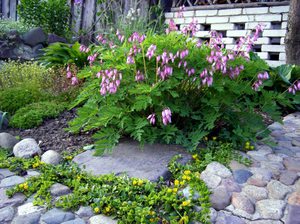 In order for the dicentra of the Zolotaya Vine variety to feel normal during the entire growing season, it must be provided with appropriate care, maintaining optimal lighting, by regular watering, weeding and loosening.
In order for the dicentra of the Zolotaya Vine variety to feel normal during the entire growing season, it must be provided with appropriate care, maintaining optimal lighting, by regular watering, weeding and loosening.
Although it is possible to grow a dicenter in both sunny and shady areas, the presence of a sufficient amount of light can greatly affect the fact how lush the bushes will be dicenters and how soon they will bloom. In the open space, the dicenter begins to bloom early. But her peduncles are not particularly large and lush. In conditions of partial shading, the dicenter begins to bloom later than usual, but rather large hearts are formed with a rich color, which adorn the site until mid-summer.
Recommendations for the care of the dicenter:
- an effective measure is to carry out superphosphate dressings in the spring. Also, this fertilizer must be applied to the soil and at the stage of growth of the dicentra. These operations will help ensure the rich color of the buds;
- after the last flower of the dicentra withers, it is recommended to apply fertilizers rich in nitrogen to the soil. This will be a good stimulating measure for the formation of new kidneys;
- with the threat of frost, it is recommended to grow a dicenter with a shelter, which can be used as a non-woven material;
- in the process of growing dicentra, it is necessary to track faded brushes and cut them off in time. In this case, the plant will bloom longer due to the timely formation of buds on other branches;
- at the beginning of autumn, it is necessary to trim the aboveground part of the plants so that after it hemp remains no more than 5 cm high;
- in addition, you need to be very attentive to the ground. If water stagnates in it, this will lead to decay of the roots. This can be avoided if the dicenter is planted on heights;
- if the site for the dicenter is chosen incorrectly, as a result of which water constantly accumulates on it, then it is possible to artificially raise the soil and arrange a drainage layer and grooves to ensure effective removal of excess moisture;
- in hot weather, it is necessary to increase the frequency of watering, as well as the rate of water consumption in order to avoid drying out of the roots. To keep moisture in the soil as long as possible and to protect the roots from overheating, it is recommended to mulch the root zone with peat or humus.
The most common varieties of dicentra
Genus dicenter includes many interesting species, and each of them can be a wonderful decoration in the garden.
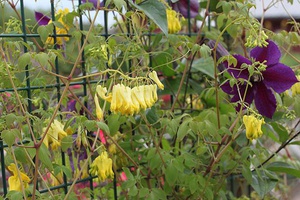 the bleeding center is magnificent. It is no coincidence that this plant is called that, because it is a fairly large plant, which becomes especially lush during flowering. Adult plants have a pronounced volumetric appearance due to openwork foliage and flowering brushes, which are densely covered with flowers. Most often, this variety is decorated in a bright pink hue, although there are plants in which white flowers grow during the growing season. The latter are shorter, but this does not prevent them from remaining as lush and beautiful;
the bleeding center is magnificent. It is no coincidence that this plant is called that, because it is a fairly large plant, which becomes especially lush during flowering. Adult plants have a pronounced volumetric appearance due to openwork foliage and flowering brushes, which are densely covered with flowers. Most often, this variety is decorated in a bright pink hue, although there are plants in which white flowers grow during the growing season. The latter are shorter, but this does not prevent them from remaining as lush and beautiful;- the bleeding center is beautiful. As a dwarf plant, this variety usually does not grow taller than 30 cm. In the spring, graceful flowers are formed, which have a variety of shades, ranging from pale white to bright purple. It blooms for a long time: the first flowers appear in the first weeks of spring and give a great mood until the end of summer. The types of dicentra are very unusual, decorated with silver leaves, which give them the effect of the presence of a barely noticeable cannon. This variety is often used to decorate curbs and alpine slides;
- the dicenter is exceptional. It belongs to the group of low-growing plants and does not grow higher than 25 cm. In spring, bluish-gray leaves appear, which are very similar in shape to a fern. Flowers of this variety, which have pink, purple or white shades, look quite attractive. The flowering of an exceptional dicentra is not particularly impressive: you can enjoy its appearance for no more than 2 months. In cooler years, flowering can last the entire season. This variety is often used for winter forcing.
- crossing of various varieties of dicentra led to the creation of a new species - curly dicentra. Representing the annual class, this plant is most commonly found in the Himalayas. Its uniqueness is given by its shape, since it looks like a long liana, reaching a height of 2 meters, the main decoration of which are beautiful yellow buds.
Conclusion
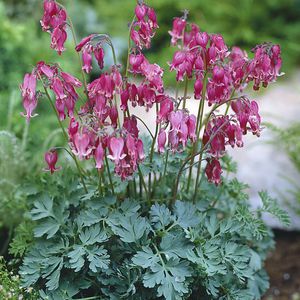 Dicentra is an excellent solution for decorating a summer cottage, which will interest those owners who want to create an unusual design with ornamental plants.
Dicentra is an excellent solution for decorating a summer cottage, which will interest those owners who want to create an unusual design with ornamental plants.
However, we must not forget that this is still an overseas plant that requires special attention at the entire stage of cultivation. In general, the dicenter is a rather unpretentious plant, so it can grow equally well in illuminated areas and in partial shade. However, the latter option is more preferable due to the fact that, being protected from bright sunlight, the dicenter forms rather large and rich inflorescences that can decorate the site until mid-summer.
